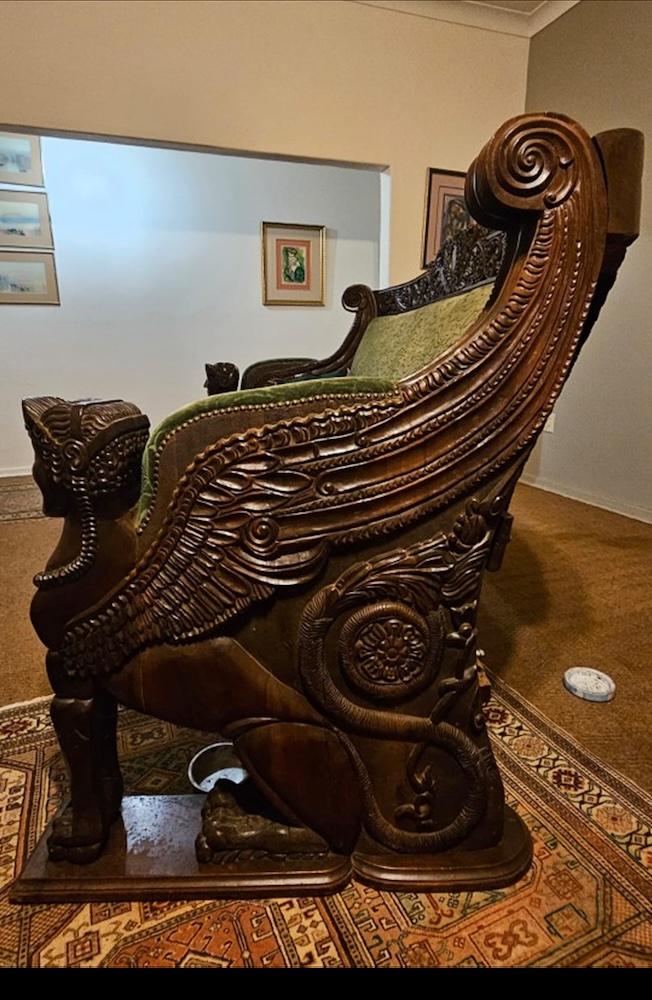Egyptianesque Sofa

How did a massive, ornately carved, reportedly uncomfortable sofa – shaped like a gondola with arms of carved walnut supporting a pair of winged sphinx figures – get to a remote farm in Buffelspoort, Rustenburg District of South Africa? This is a short story about how the most out of place objects are usually found in the least likely environments. Mrs. K of this farm sent me photos and asked if I could help identify the sofa. Her husband’s grandfather purchased this farm in the ‘60s and the sofa resided there at the time. Now it is hers! She has done great sleuthing work on the style, and successfully finds her sofa’s antecedents in the Louvre – in the form of two 4th century BCE carved marble thrones, one dedicated to Bacchus and one to Ceres. She also sends me a photo of the identically shaped and themed throne of Emperor Napoleon Bonaparte (with winged guardian sphinxes) from the Versailles Museum. She is right to begin her research with STYLE.
This beast of a sofa represents one of the most fascinating styles of design, popular during two resurgences throughout the 19th and early 20th c. in Europe and the U.S. Mrs. K owns an Egyptianesque – or Egyptian Revival work – of great craftsmanship. The first iteration of the style was due to the great discoveries made during Napoleon’s “expedition” to Syria and Egypt 1789-1801 in which meticulous topographical surveys were made, all aspects of natural history and culture were investigated and documented and, famously, ancient Egypt was discovered – the temples and tombs of Luxor, Philae, Dendera, and the Valley of the Kings. Thus, Emperor Napoleon’s throne was designed à la Egypt, and this became the dominate style of the French Empire period (1804-1815). All the elements you see on Mrs. K’s sofa were represented: carved falcon wings, sphinx supports, lotus blossoms, winged orbs, monopodia griffins, lotus leaf detailing, plinths instead of legs, and plenty of acanthus leaf carvings, all converging in a strong angular design. The style became popular in Regency England in the second quarter of the 19th c., popularized at the Prince of Wales’s Brighton Pavilion. Egyptian Neoclassicism swept through Europe; even Sweden had a version.
The style had a second resurgence in the late 19th century when many more Classical ruins were discovered and learned people of the U.S. and Europe studied the ruins of Troy, Assyria, and Pompei, to name a few archeological treasures. A geographical revolution was underway, launching renewed interest in classically designed furniture. By the 1870s posh design firms were actively working in Egyptian or Neo-Grec Revival. A premier New York based firm, Pottier and Stymus, was known for high style furniture in the Neo-Greco and Egyptian Revival Styles. Herter Brothers was another high-end firm designing massive pieces in this style. The late 19th century Philadelphia Centennial Exhibition displayed furniture similar to that owned by Mrs. K on her farm in South Africa! Tiffany Glass and Decorating Company in New York City hired the Italian Egyptian Revival designer Michelangelo Guggenheim, who from his studio appointed prominent Venetian palaces in this style.
I have a suspicion that Mrs. K’s sofa is the work of this designer; Guggenheim’s furniture was overscale and imposing, and his figures, such as his Winged Sphinx, were almost surreal. Tiffany Studios was pleased to offer Guggenheim’s work in New York in the 1890s as well as in Europe. The very wealthy of Venice, New York, and Paris hired designers to create an overall impression of Egyptian grandeur.
We would know if I am right about the craftsmen behind Mrs. K’s sofa if she can find a label “Stabilimento Artistico M Guggenheim Venezia.” If she has a sofa created by Pottier and Stymus, on the other hand, she will find the same number stamped on each of the parts of the sofa, or a stamp ‘PS.’
She mentions a worldwide phenomenon; her kids do not want this sofa, and she asks if it is worth holding onto or if the market will want it. The sofa is not in perfect shape, she says, and asks if she should restore it. Even if the makers were either Guggenheim or Pottier and Stymus in the late 19th century, this style of furniture is NOT desired. An entire seven-piece bedroom set in this style by Guggenheim achieved $20,000 at auction, a similar table in this design, $3,000, and a chair by Pottier and Stymus achieved $1,800. So I would suggest neither refinishing nor reupholstering, but a nice donation to a museum in
South Africa!







You must be logged in to post a comment.